10 Key HR Metrics for Effective Business Management in 2023
To compete in the cutthroat economic environment of today, firms' decisions must be based on data. HR analytics can help in this situation. Organizations may make data-driven decisions that are in line with their strategic goals by using the useful insights that HR metrics give them into the performance of their workforce and the efficacy of their HR initiatives. Unlocking success through crucial HR KPIs is now more important than ever in 2023 as the corporate environment becomes more complex and dynamic. In this blog, we'll look at the key HR metrics that businesses need to monitor in 2023 if they want to enhance their workforce management plans and achieve long-term success. We will explore the significance of each indicator, including turnover rate and productivity measures, how to measure them, and how to use the results to improve HR initiatives and the employee experience. Organizations may unleash the potential of data-driven decision-making and accelerate performance in 2023 and beyond by understanding the critical HR metrics for efficient business management.
What are HR Metrics?
HR metrics are a set of quantitative measurements used by businesses to assess the efficacy and efficiency of their human resource operations. HR professionals and business leaders require HR metrics in order to track and assess employee performance, identify areas for improvement, and make data-driven decisions. HR metrics address a wide range of themes, including employee engagement, talent acquisition, retention, development, and performance management. HR indicators include the cost per hire, time to fill a position, training, and development costs per employee, absenteeism rate, employee satisfaction rating, and productivity rate. Using HR metrics, organizations may learn a lot about the effectiveness of their HR policies and programs. For example, turnover rate data can reveal whether a company has a high rate of voluntary departures, which may indicate issues with employee happiness or inefficient retention tactics. Metrics such as time to fill and absenteeism rate can identify potential issues with employee engagement and well-being, whereas time to fill can demonstrate how effective and efficient the organization's recruitment process is.
In general, HR metrics provide a tool to assess the success of HR activities and link them to the company's strategic goals. Organizations can improve their decision-making processes and workforce management approaches to encourage long-term success by collecting and analyzing data on a regular basis.
What are the Most Important HR Metrics?
The most essential HR indicators will differ depending on the organization's goals and specific issues. However, the following are some critical HR measures that are often regarded as critical for good corporate management:
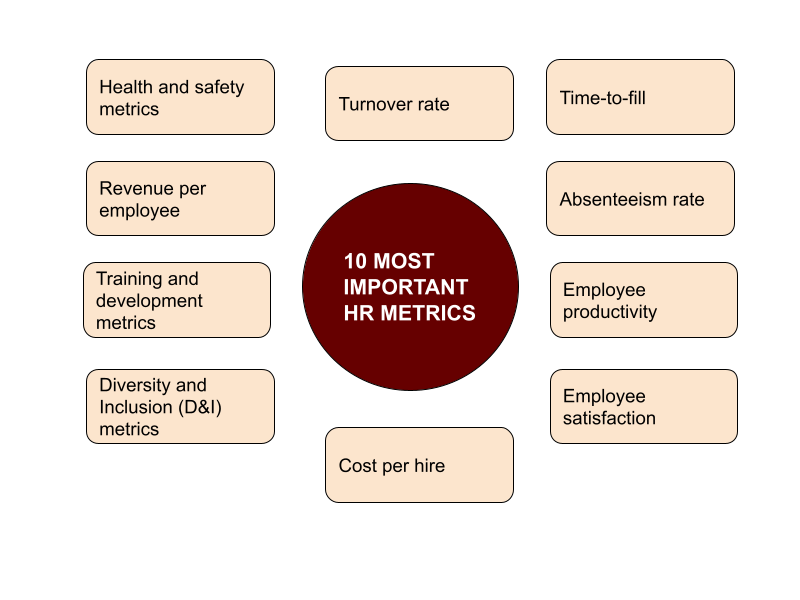
1. Turnover Rate:
The turnover rate is an important HR metric that counts the percentage of employees who leave a company during a given time period, usually a year. This indicator is determined by multiplying the number of employees who departed the business by the average number of employees over the same period by 100.
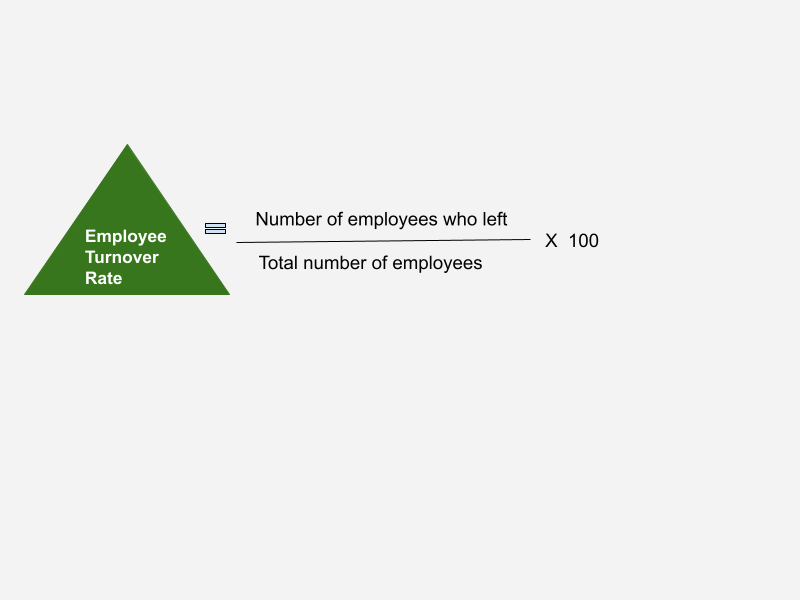
A high turnover rate, among other things, can suggest problems with employee engagement, job satisfaction, or leadership effectiveness. Employee turnover can be costly for a company, resulting in the loss of institutional knowledge, lost productivity, and increased recruitment and training expenditures.
Voluntary turnover and involuntary turnover are the two types of turnover rates. The percentage of employees that leave the organization voluntarily, such as by resigning or retiring, is referred to as voluntary turnover. The percentage of employees who are terminated or laid off by the business is referred to as involuntary turnover.
Organizations can discover areas for development and take steps to retain outstanding people by analyzing turnover rates. Overall, tracking turnover rate is crucial for effective workforce management and can help organizations retain top talent, reduce recruitment and training costs, and drive long-term success.
2. Time-to-Fill:
Time-to-fill is an HR metric that quantifies the number of days it takes to fill a vacant position, beginning with the posting of the job opportunity and ending with the candidate accepting the offer. This statistic is crucial since a long time-to-fill might result in lower production and higher costs for the firm.
A long time-to-fill can suggest a number of problems in the hiring process, such as a lack of competent candidates, an inefficient hiring procedure, or a low offer acceptance rate. These issues can be costly to a company because they result in lost production and increased workload for the remaining employees. Organizations often begin calculating time-to-fill by determining the date the job opportunity was posted and the date the new hire accepted the offer. The time-to-fill metric is the number of days between these two dates.
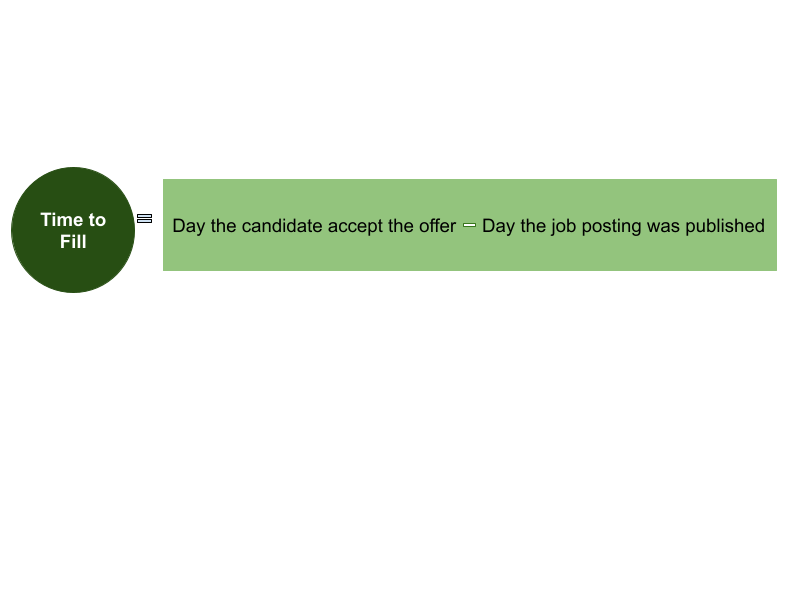
After calculating the time-to-fill statistic, an organization can use it to detect trends and patterns, such as which departments have higher time-to-fill rates or which job titles take longer to fill. This data can assist firms in identifying areas for development and adapting their recruitment strategy accordingly.
Implementing techniques such as boosting the reach of job posts, streamlining the application and interview process, giving competitive remuneration and benefits, and developing a strong employer brand can all help to reduce time-to-fill. Organizations may enhance productivity, lower the stress on current workers, and ultimately drive success through minimizing time-to-fill.
3. Absenteeism Rate:
The absenteeism rate is an important HR metric that calculates the percentage of time employees miss work. It is determined by multiplying the number of absence days by the total number of workdays for a given time by 100.
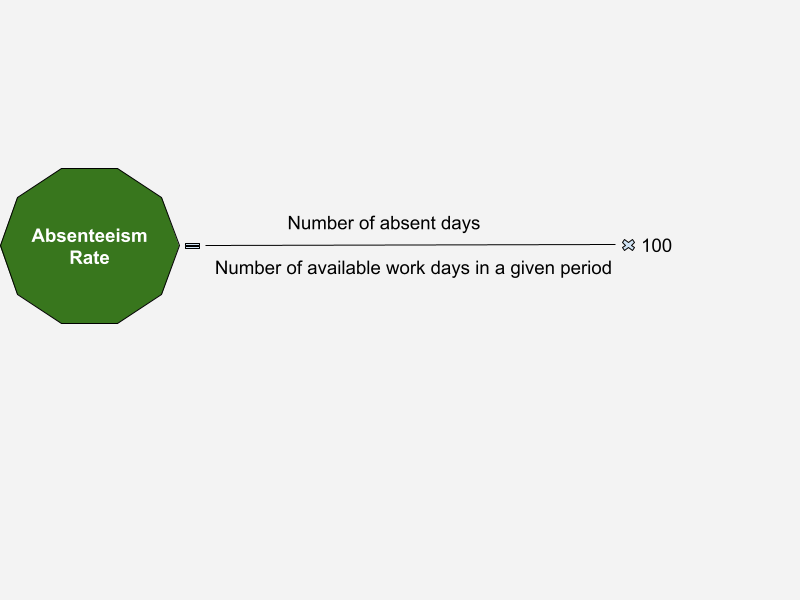
Absenteeism can have a substantial impact on the production, morale, and overall success of an organization. Employee disengagement, unhappiness, burnout, or even health problems can all be indicators of high absenteeism rates. It may also result in greater workload for remaining staff, which may have a negative influence on productivity and morale.
Measuring absenteeism rates can assist businesses in identifying patterns and trends in employee attendance, which can then be used to address underlying issues. The absence rate can also assist firms in identifying employees who may require additional support or accommodations. In general absenteeism rate is a crucial HR indicator that can give important information about a company's workforce management tactics. Organizations may increase employee engagement, productivity, and overall performance by monitoring absenteeism rates and identifying underlying problems.
4. Employee Productivity:
Employee productivity is a crucial HR indicator that gauges the output of specific teams or individuals over a predetermined time period. It is a crucial metric since it offers information about the effectiveness of the organization's use of its human resources as well as employee performance. An organization must establish and monitor its employees' progress toward specific goals and objectives in order to quantify the employee productivity. This can be accomplished by having management regularly evaluate employee performance in relation to their goals and offer feedback.
The availability of training and development opportunities, workplace culture, workload, and work-life balance are all elements that might affect employee productivity. Employee productivity is more likely to increase when they feel engaged, motivated, and supported, whereas it may drop when they feel overburdened or unsupported. Organizations can use tactics including offering employees chances for training and development, rewarding outstanding performance, fostering a positive work environment, and making sure that employees have a manageable task to increase employee productivity.
Employee productivity is a critical HR indicator that can offer important information about a company's workforce management tactics. Organizations may boost their bottom line, increase employee engagement and satisfaction, and promote long-term success by measuring and optimizing productivity.
5. Employee Satisfaction:
Employee satisfaction is a metric that assesses how pleased and content employees are with their employment, work environment, remuneration, perks, and overall job experience. High levels of employee satisfaction are essential for attracting and retaining top talent as well as building a pleasant workplace culture. Employee satisfaction is often measured by the administration of surveys or questionnaires that ask employees about their job satisfaction levels. Job duties, work-life balance, compensation and benefits, career development possibilities, leadership effectiveness, and workplace culture are some of the subjects included in these surveys.
Employee satisfaction surveys can provide useful information about the efficacy of an organization's HR programs and management practices. Measuring employee satisfaction has various advantages. For starters, it can assist firms in identifying areas where employee engagement, productivity, and retention can be improved. Second, it can assist firms in developing a positive workplace culture that promotes employee happiness and productivity. Third, in a competitive labor market, it can assist firms in attracting and retaining top people.
Overall, evaluating employee happiness is an important HR metric because it may provide useful insights into an organization's workforce management methods, allowing HR professionals and business leaders to make data-driven decisions that generate long-term success.
6. Cost Per Hire:
Cost per hire is a human resources metric that calculates the cost of recruiting and hiring a new employee. This measure includes all costs involved with the recruitment process, such as advertising, candidate screening, interviewing, testing, and other related expenses. Organizations can obtain insight into the efficiency of their recruitment processes and find areas for improvement by analyzing the cost per hire.
Organizations must collect data on the expenses incurred throughout the recruitment process, such as job board fees, recruitment agency fees, background checks, travel expenses, and relocation charges, in order to assess the cost per hire. Following the collection of data, the overall recruitment cost is divided by the number of hires made within the same time period.
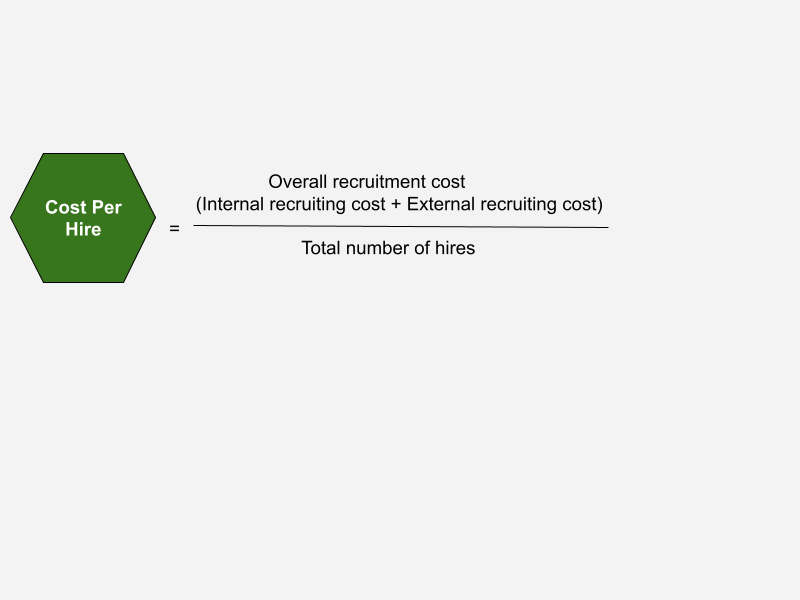
Overall, the cost per hire is an important HR statistic that can assist firms in tracking recruitment costs and identifying areas for improvement. Organizations may optimize their recruitment efforts and make data-driven decisions that match with their strategic goals by measuring this measure on a regular basis.
7. Diversity and Inclusion (D&I) Metrics:
Diversity and inclusion (D&I) indicators are critical for determining the success of an organization's diversity and inclusion programs. These indicators assist HR professionals and business executives in tracking progress toward D&I objectives, identifying areas for improvement, and making data-driven decisions that promote a more diverse and inclusive workplace. The following are some essential D&I metrics that businesses should consider tracking:
* Diversity representation: This indicator assesses the workforce's representation of various demographic categories such as race, gender, age, and ethnicity. It can assist in identifying representation gaps and ensuring that the workforce reflects the diversity of the population served.
* Employee engagement: This statistic assesses employees' level of involvement and sense of belonging inside the firm. Employees with high engagement levels may feel valued and respected, whereas low engagement levels may signal concerns with inclusiveness or leadership.
* Promotion rates: This indicator assesses the rate of advancement of various demographic groupings within the company. A lack of diversity in promotion rates might be an indication of bias or discrimination in the promotion process.
* Turnover rates: This indicator evaluates the turnover rates of the organization's various demographic categories. High turnover rates for underrepresented groups may suggest inclusion or discrimination issues.
* Pay equity: This indicator assesses pay equity across various demographic groupings within a company. A lack of pay equity can be an indication of bias or discrimination in the compensation process.
* Supplier diversity: This metric tracks the amount of money spent by the organization on diverse suppliers, such as minority- and women-owned businesses. It can assist the firm in ensuring that its supplier chain reflects its commitment to diversity and inclusion.
As a whole, these diversity and inclusion indicators can provide significant insights into an organization's progress toward becoming a more diverse and inclusive workplace, allowing HR professionals and business executives to identify areas for improvement and make data-driven decisions that create long-term success.
8. Training and Development Metrics:
Training and development metrics are a type of human resource metric that assesses the efficacy of an organization's training and development programs. These indicators are critical for determining the ROI of these programs and suggesting areas for development. Here are a few examples of common training and development metrics:
* Training effectiveness: This indicator assesses the impact of training programs on staff productivity and performance. It can be assessed before and after training, as well as through surveys and evaluations.
* Training participation rate: This indicator calculates the percentage of employees who attend training sessions. A low participation rate may suggest a lack of interest in training programs or a need to improve their relevance or quality.
* Cost per employee training: This metric measures the cost of training per employee. It can assist firms in determining the ROI of their training programs and identifying cost-cutting opportunities.
* Time to competency: This metric assesses how long it takes employees to learn the skills and information they need to do their job well. It can assist companies in assessing the effectiveness of their training programs and identifying areas where further assistance or resources are required.
* Employee engagement in training: This metric measures the level of employee engagement and participation in training programs. It can assist organizations in determining the relevance and efficacy of their training programs, as well as identifying opportunities for development.
* Employee performance improvement: This metric assesses how well employees perform after receiving training. It can assist companies in evaluating the effectiveness of their training programs and identifying areas that require extra training or support.
In all, training and development indicators are critical for assessing program efficacy and finding areas for improvement. Organizations may optimize their training and development initiatives, boost employee performance and productivity, and drive long-term success by tracking these indicators.
9. Revenue Per Employee:
Revenue per employee (RPE) is a financial metric that measures the amount of revenue generated by an organization per employee. It is computed by dividing the organization's total revenue by the number of employees.
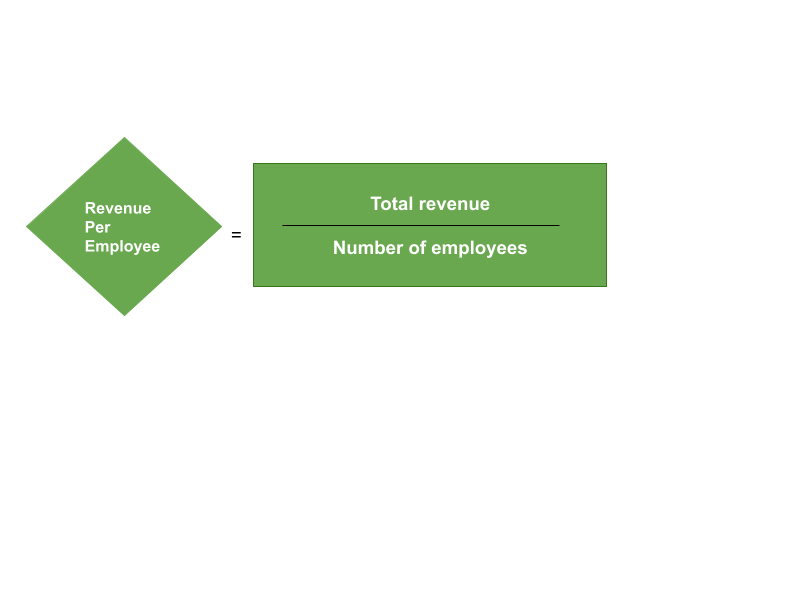
The RPE metric is crucial because it provides insight into an organization's workforce's efficiency and productivity. A high RPE, for example, may imply that a company is making large money with fewer personnel, indicating a productive and efficient staff. A low RPE, on the other hand, may suggest that a company is not earning enough money with its current personnel, which may indicate problems with employee productivity, efficiency, or effectiveness. RPE can be influenced by a variety of factors, including the organization's industry, business model, and size. Service-based enterprises, such as consulting firms, often have higher RPE values than manufacturing firms, which require a larger staff to manufacture things. Smaller firms may have higher RPE values than larger organizations because they can run more efficiently with a smaller staff.
Thus, RPE is a crucial indicator for analyzing an organization's workforce productivity and efficiency. Organizations may detect trends and patterns, make data-driven decisions, and optimize their workforce management strategies by tracking RPE over time.
10. Health and Safety Metrics:
Health and safety metrics are a set of measurements used to assess an organization's success in safeguarding the health and safety of its personnel. These indicators provide vital insights into the efficacy of the organization's health and safety programs and highlight opportunities for development. Here are some critical health and safety metrics:
* Lost time injury rate: This indicator counts the number of workplace injuries that result in lost work time per 100 employees during a given time period. A high lost time injury rate can suggest that an organization's health and safety programs need to be improved.
* Total recordable injury rate: This metric calculates the total number of workplace injuries, including those requiring medical treatment, restricted work activities, or job transfers, per 100 employees over a given time period.
* Severity rate: This metric calculates the number of lost workdays per 100 employees over a given time period to determine the severity of occupational injuries.
* Near-miss reporting rate: This indicator counts the number of near-miss incidents reported per 100 employees within a certain time period. Near-miss reporting assists businesses in identifying potential hazards and preventing accidents from occurring.
* Safety training hours: This metric counts the number of hours of safety training given to employees over a given time period. Safety training is critical for informing employees about workplace hazards and lowering the risk of workplace accidents.
* Employee participation in health and safety programs: This metric calculates the percentage of employees who take part in health and safety programs such as safety committees, safety audits, and safety exercises. A high rate of participation can suggest a safe culture inside a company.
In all, health and safety metrics provide useful insights into an organization's health and safety programs, allowing them to identify areas for improvement and make data-driven decisions to guarantee their employees' health and safety.
Why do HR metrics matter?
There are several reasons why HR metrics are important, including their capacity to offer insightful data about the productivity of an organization's personnel and the success of its HR initiatives. HR metrics are significant for the following reasons:
1. Measure the effectiveness of HR programs: HR metrics assist firms in evaluating the efficacy of their HR initiatives and programs. An organization can assess the effectiveness of its hiring process by measuring metrics like the cost per hire and the time it takes to fill a position, for instance. In turn, this can assist in pinpointing problem areas and streamlining the hiring procedure for improved outcomes.
2. Monitor workforce performance: HR metrics provide a means of monitoring workforce performance and identifying trends that may impact an organization's success. Absenteeism rate measurements, for example, can assist in identifying possible concerns with employee engagement, well-being, or workload. Employee satisfaction scores can assist a business understand how to boost employee engagement by providing insight into how satisfied and motivated its employees are.
3. Motivate strategic decision-making: HR metrics provide information that may be used to make educated decisions. Organizations can find areas for improvement and make data-driven decisions that correspond with their strategic goals by examining HR indicators. A high turnover rate, for example, may suggest the need for greater retention measures, whilst low productivity rates may necessitate improved training and development programs.
4. Enhance employee experience: By highlighting areas for improvement, HR metrics can assist improve employee experience. Employee satisfaction scores, for example, can assist a business in understanding employee requirements and expectations, allowing them to implement adjustments that improve the entire employee experience.
HR metrics, in general, are critical for firms that seek to optimize their workforce management methods and drive long-term success. Organizations can get significant insights into the performance of their workforce and the efficacy of their HR programs by collecting and evaluating HR metrics on a regular basis, allowing them to make data-driven decisions that support their strategic goals.
How to use HR metrics?
HR metrics are critical tools for HR professionals and company leaders to use in tracking and analyzing worker performance, identifying areas for development, and making data-driven choices. Here are some tips on how to successfully use HR metrics:
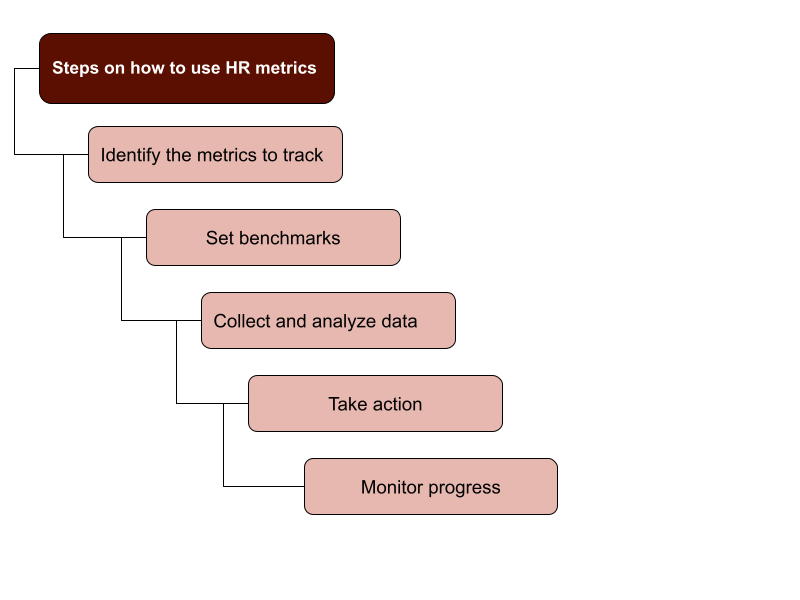
1. Identify the metrics to track: The first step is to identify the HR metrics that are relevant to your HR programs and align with your organization's strategic goals. For example, if your organization's goal is to promote employee engagement, you may want to monitor employee satisfaction, absenteeism, and turnover rates.
2. Set benchmarks: Once you've determined which metrics to track, establish benchmarks for each indicator based on industry norms or your organization's past performance. This will serve as a baseline for comparison and will allow you to find areas for improvement.
3. Collect and evaluate data: Gather and analyze data on a regular basis to detect trends and patterns. This will allow you to acquire insight on your workforce's performance and the success of your HR programs.
4. Take action: Apply the analysis's insights to take action and create data-driven decisions. For example, if you have a high turnover rate, you may want to reconsider your retention strategy or make improvements to the employee experience to boost engagement.
5. Monitor progress: Constantly monitor metrics and track progress to ensure that adjustments are having the desired effect. This will allow you to make any necessary adjustments and ensure that your HR programs remain aligned with your strategic goals.
In all, effective use of HR metrics necessitates a methodical strategy that includes selecting relevant measures, creating benchmarks, collecting and evaluating data, acting, and monitoring progress. Organizations can use HR analytics to optimize their workforce management strategies and drive long-term success by following these steps.
Conclusion:
In conclusion, in 2023, HR measurements will be key tools for effective business management. Organizations may obtain important insights into their workforce, discover areas for growth, and make educated decisions that promote success by collecting and evaluating data on key performance metrics. The most essential HR metrics vary depending on the aims and objectives of each firm, but some frequent ones are turnover rate, employee engagement, and productivity. To effectively employ HR metrics, firms must create clear goals, acquire correct data, evaluate that data on a regular basis, and disseminate insights to important stakeholders. Businesses that take the proper approach to HR metrics can unlock the full potential of their personnel and achieve long-term success.